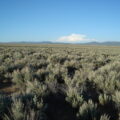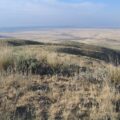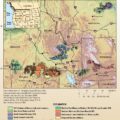[ad_1]
A team of 94 scientists and specialists from 34 federal and state agencies, universities and non-governmental organizations contributed to the comprehensive assessment of the sagebrush ecosystem, which covers 14 western states and two Canadian provinces. The effort was coordinated by the Western Association of Fish and Wildlife Agencies (WAFWA) with support from the U.S. Fish and Wildlife Service, Bureau of Land Management, U.S. Geological Survey (USGS), state wildlife agencies and universities.
The report highlights continuing pressures from unprecedented wildfires fueled by invasive annual grasses, as well as cropland conversion and disturbance associated with development of other resources. These changes impact not just wildlife but also diverse human communities that depend on healthy sagebrush for their wellbeing.
“In order to effectively counter challenges, we first have to understand them,” said Director of the Nevada Department of Wildlife and Chairman of the Sagebrush Executive Oversight Committee coordinated by WAFWA Tony Wasley. “This report gives us a clearer understanding of these threats as well as how to restore degraded sagebrush rangelands and communicate the need for conservation to the public. It’s clear while we individually are winning many battles, we are at risk of collectively losing the war to conserve sagebrush, particularly with regard to fire and cheatgrass.”
The report describes how a warming climate, increasing fuel loads from cheatgrass and other invasive annual grasses, and human ignitions lead to mega-fires that consume sagebrush at a rate that can outpace its ability to recover naturally or to fully benefit from post-burn restoration efforts. It also examines how current efforts to conserve sagebrush areas designated as habitat for greater sage-grouse are also likely to conserve other species that are dependent on or associated with sage-steppe ecosystems.
“Our knowledge about sage-grouse and the sagebrush ecosystem has increased dramatically over the past two decades through multi-agency efforts to study and manage sage-grouse populations and their habitats,” said report editor and USGS Fort Collins Science Center Deputy Director Steve Hanser. “However, many challenges and uncertainties remain. This report sets the stage for policymakers, managers and scientists as they refine and develop conservation strategies.”
A report led by this same multi-agency team and to be published by the USGS later this year will outline options to help coordinate, prioritize and improve effectiveness of the actions taken by the hundreds of stakeholders engaged in sagebrush conservation as well as increase capacity for conservation in the sagebrush biome.
“The bottom line is, sage-grouse conservation efforts are a great start, but we can’t just assume that these alone are going to take care of mule deer migration routes, wintering areas, pygmy rabbits, pronghorn or human needs from these landscapes,” said Tom Remington, the report’s lead editor and WAFWA coordinator of this project. “There are many examples where state, federal or private efforts are successfully addressing these challenges collaboratively. We can conserve the sagebrush biome if we coordinate our actions to emulate these and scale them up.”
###
[ad_2]
Source link
- Warmer water could cool Montana’s trout fishing economy - September 7, 2022
- Water Released from Crystallizing Magma can Trigger Earthquakes in Yellowstone - September 5, 2022
- Thermal Infrared Remote Sensing at Yellowstone 101 - August 29, 2022




